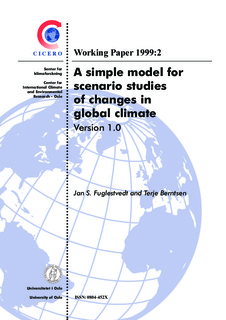A simple model for scenario studies of changes in global climate: Version 1.0
Working paper
Permanent lenke
http://hdl.handle.net/11250/192444Utgivelsesdato
1999Metadata
Vis full innførselSamlinger
- CICERO Working Papers [167]
Sammendrag
This paper gives a documentation of a simple climate model for studying the effects of future climate gas emissions on global mean temperature and sea level. Input to the model is global emissions of 29 gases. Atmospheric concentration of carbon dioxide (CO2) is calculated on the basis of work published by Joos et al. (1996).
The parameterisation is founded on complex models for the carbon cycle where the exchange of carbon between the atmosphere, the biosphere and the oceans is considered. Future concentrations of other gases are calculated by standard equations based on emissions and chemical decay of the different gases in the atmosphere. Radiative forcing from the modelled concentrations in source gases is calculated by applying standard parameterisations published in the literature. In addition, radiative forcing is calculated for soot and sulphate aerosols (direct and indirect effects) as well as the secondary components tropospheric and stratospheric ozone and stratospheric water vapour.
The estimated radiative forcing serves as input to an energy-balance-climate/upwelling-diffusion-ocean model developed by Professor Michael E. Schlesinger (Schlesinger et al., 1992). The global and hemispherical change in annual mean temperature is calculated based on the exchange of energy between the atmosphere and the oceans, and the transport of energy in the ocean. The model uses prescribed values for climate sensitivity based on GCM results. The change in sea level rise is both determined by the melting of glaciers and the thermal expansion of the ocean.
The model is similar to those applied by IPCC for scenario studies (IPCC, 1996 p 316-318; IPCC, 1997; Wigley and Raper, 1992). Presently, the model serves as a useful tool in the analysis of possible global climatic changes caused by present and future greenhouse gas emissions. However, the intention is to extend the model so that regional predictions of temperature and other climate variables can be carried out.
